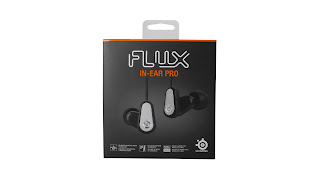 Only the laziest of writers would quote from a press release in the first paragraph of their review. So, now that we know where we stand, here’s what SteelSeries have to say about their Flux In-Ear Pro headset:
Only the laziest of writers would quote from a press release in the first paragraph of their review. So, now that we know where we stand, here’s what SteelSeries have to say about their Flux In-Ear Pro headset:
“The balanced armature driver requires no external air to produce sound. This means the driver can be made to be very small and it also means that it can be tuned very precisely. With this precise tuning the driver can recreate sound with an extreme level of accuracy providing an amazing audio experience in a very compact, comfortable design.”
… and I couldn’t have put it better myself. The clarity is remarkable. This is a headset for those who like to hear every detail: the sound of a singer’s breathing, the subtle reverb added by the mixing desk, the rasp of fingers on guitar strings, individual monsters in a game of Diablo 3. If you like to concentrate on the noises being piped into your head then you’ll be in heaven with the In-Ear Pro. These are the most technically accomplished earbuds that I’ve used.
However, there’s something you need to consider before you hasten to the shops. The Flux In-Ear Pro provides a beautifully balanced soundscape in which each and every frequency assumes its proper place. Trebles are bright and clear, the bass is clean and undistorted, and the vocal range sparkles like the morning dew. But the price is a distinct lack of thump. This isn’t a headset that produces a down-and-dirty sound. Instead, it’s a product for those who appreciate the hidden intricacies of music. Think Rush, rather than Black Sabbath. Jean-Michel Jarre rather than Rick Wakeman. Roll rather than rock.

And that brings us seamlessly to the subject of ergonomics. Earbuds excel because of their small form-factor. They’re light to wear and easy to pack, but they can get into a hell of a knot. The Flux In-Ear Pro solves the problem by featuring tangle-resistant ribbon for the lower section of the cabling, with a tiny break-out unit connecting to thin wires in the upper portion. It’s a system that works well, although it does tend to make the cable a little heavier than I’d like. SteelSeries suggest that the earpieces should be worn in an over-ear configuration for the best sound, but a less cumbersome conventional fitting is also possible. Finally, the headset comes with supplied with three sets of silicone buds and an excellent set of noise-isolating (but slightly ear-stretching) memory-foam tips.
There are a couple of negatives to point out. Firstly, the inline microphone really isn’t very good. In our tests, the transmission volume was so low that Windows initially failed to recognise it at all. This was easily solved using a combination of soundcard and application settings, but the recording quality was disappointing in comparison to the standards set by the rest of the unit. It’s a similar story for iPhone use: here, the volume was fine but there was a significant amount of background hiss. Additionally, the Flux range seems to amplify computer noise fairly readily: if you’re planning on using one with a PC, make sure that your sound card is interference-free before you start. It’s also likely that you’ll need extension cables and a splitter if you need to use the ports at the back of your machine.
Those points aside, the Flux In-Ear Pro is a quality piece of kit. The lack of urban-style bass means that they won’t suit everyone, and I’d recommend SteelSeries’ standard over-ear Flux as an excellent alternative for everyday use. However, if you like to listen – really, really listen – then these might be the earbuds for you.
– Rob P.
Contributor
Our Scoring Policy







